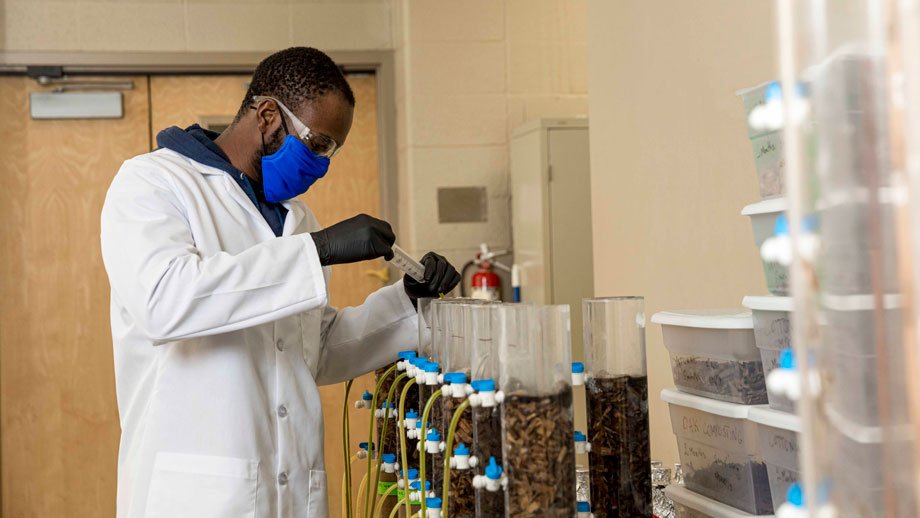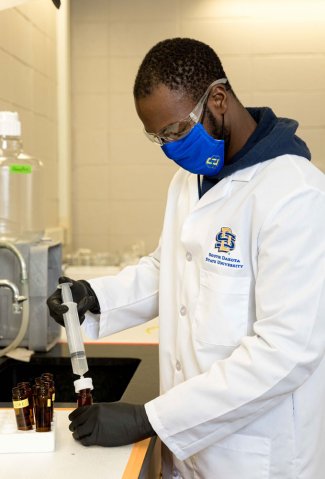
Draining excess water from fields is good for agricultural production, but the nutrient-laden water flowing through the drainage tile can pollute nearby water bodies. Diverting the water through an underground chamber filled with wood chips, known as a woodchip bioreactor, can help remove nitrates and thereby reduce the environmental impact on creeks, streams and lakes.
“Bacteria that grow on the woodchips degrade the nitrates,” explained South Dakota State University associate professor Guanghui Hua, who has been doing research on woodchip bioreactors since 2014. Though woodchip bioreactors have been used for several decades, most of the research has focused on performance parameters, such as reactor size, water temperature, water flow and nitrate removal rates.
Very little research has been done on the quality of woodchips, Hua explained. “Many things can occur before the woodchips are put into the reactor. The chips can be exposed to sunlight, moisture, bacteria or even fungi—the woodchip quality can be changed by the natural weathering process.”
Hua, professor Chris Schmit and lecturer Kyungnan “Karen” Min of the Department of Civil and Environmental Engineering are evaluating the efficiency of fresh and weathered woodchips for bioreactors. The research is supported by the U.S. Geological Survey 104B Grants Program administered through the South Dakota Water Resources Institute and an in-kind match from the Department of Civil and Environmental Engineering. Doctoral student Abdoul Aziz Kouanda is also working on the project.
Testing weathered versus fresh woodchips

The researchers obtained fresh cottonwood and oak woodchips from a Sioux Falls supplier and then subjected portions of the woodchips to different types of weathering for five months. One batch of was exposed to sunlight alone, another was composted with soil and water/moisture and the final one was subjected to natural outdoors conditions.
To compare the performance of the fresh and weathered woodchips, the researchers ran simulated drainage water through a column reactor and then evaluated the nitrate removal rates. “We use the same flow rate for the column reactors to achieve a flow through time of 12 hours, which is a typical bioreactor time,” Hua explained. The continuous flow column testing, which began in October, will be completed by March.
Overall, the weathered woodchips performed better than the fresh woodchip sample, Hua reported. “The natural weathering process can enhance the bioreactor efficiency for nitrate removal. That’s encouraging because natural storage is practical.”
Furthermore, Hua said, “we found solar-treated woodchips perform better than naturally weathered chips and the naturally weathered chips are better than the composted woodchips.”
Evaluating wet-dry cycling
Generally, a woodchip bioreactor is most efficient immediately after installation. “Over time, the woodchips lose organics, the food source for the bacteria that remove the nitrates, so the efficiency declines,” Hua explained. The greatest decline occurs the first year and then slows.
In the bioreactor, water constantly flows through the woodchips. Hua and his team are evaluating whether using wet and dry cycles can change the quality of the organics and therefore help stabilize the removal rates. That would mean using control gates to stop the flow of water through the woodchips in the bioreactor at specific intervals.
To test this concept, the researchers will use fresh cottonwood chips and ones that have been prepared using the three different weathering conditions. Using the bioreactor column, they will start and stop flows of simulated drainage water at intervals ranging from several days to a week and then determine the nitrate removal rates.
Previous studies at other universities have shown that the wet-dry cycling can improve the bioreactor’s efficiency, Hua noted. He hopes to complete this portion of the project this summer.
Republishing
You may republish SDSU News Center articles for free, online or in print. Questions? Contact us at sdsu.news@sdstate.edu or 605-688-6161.

